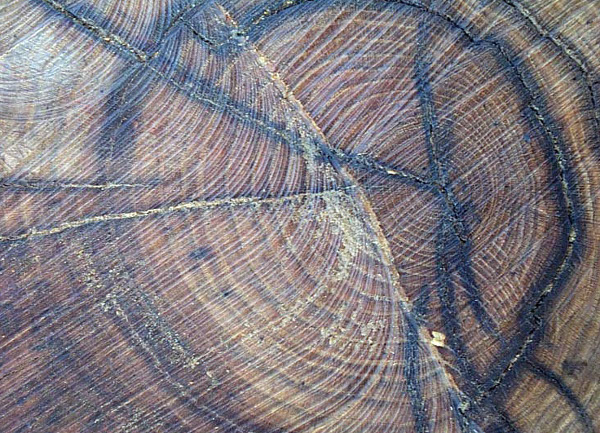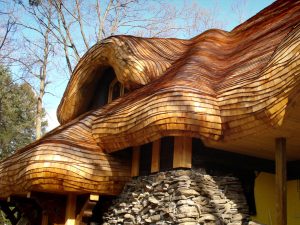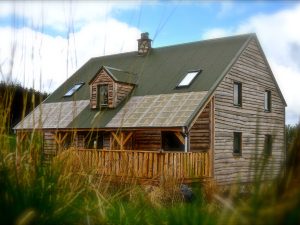This article holds some clues to the faults in timber most commonly found in Oak and Sweet Chestnut, but I have also encountered it in Southern Yellow Pine. For the novice, timber shake may sound a bit nautical or piratical, but it is a fault in growing trees that is only apparent when the tree is felled. So for any woodland owner it can have a devastating effect on income through timber quality degradation. Shake, as will be apparent later in this article, means that the wood can just fall apart after it has been milled. With ring shake the tree splits (whilst growing) around an annual growth ring so that when milled a board will just fall into 2 or 3 pieces, or with star shake the tree splits internally during the growing process in a radial pattern from the center creating the same effect when milled, plus there is a greater chance with star shake for rot to start in the butt which commonly where the best timber quality is found. In both cases it can make the timber quite useless for anything beyond firewood and represents a loss of resource to the wood user and of income to the grower.

140-year-old oak.
There has been much debate over the causes of timber shake and this article seeks to collect these together and add my own experiences to explain what causes this problem.
Not many people are aware of the disappointment when that lovely Oak butt shows signs of ring shake a short while after felling, or immediately shows star shake. Worse still when rot has got into star shake. The butt looks a complete mess and one is left with the quandary of how far does the defect go, and how many Hoppus foot have been lost? In the photo the dark stain around the shake only appears some time after felling, and with ring shake the butt may look fine for the first few hours until the air reacts with the timber and the shake becomes apparent. The problem seems primarily but not exclusively to be found in Oak and Sweet Chestnut, and always in the larger diameter trees.

Star and ring shake.
I started to contemplate the reasons for this problem some years ago building on my experience of air and kiln drying local freshly sawn timber used in our staircase joinery business. Having seen the effects of drying mistakes in both air and kiln drying I added this experience to the theory gained during my degree course (after the building industry crash of the early nineties). It all seemed to make sense when considering the effects of unregulated drying in a log laid out in the sun. Normally in this case a radial crack forms from the heart to the closest outside face, especially noticed when the heart (pith) is off center. In the early noughties my article on this subject was published in the QJF, where it quietly roosts, so it is time to highlight my thoughts on this subject again.

Radial split.
The moisture content of timber was the obvious place to start. There are basically two types of moisture in timber, free and fixed water. The free water is found within the cell enclosures and comprises that moisture that contributes to content above approximately 30%. The removal of this water has little appreciable effect on timber size if appropriate drying methods are used. The nominal 30% moisture content is referred to as the fibre saturation point, and below this the moisture is found within the cellulose cell walls. The removal of this fixed water has a considerable effect on cell size and so therefore timber size. As a board dries it shrinks in width and thickness considerably more than length.
From this I could see that timber laid in the sun would lose moisture content from the cells in the outside layers but not from the core. This loss would make the outside layers shrink and so would effectively be too small to fit around the wet central core, hence the crack. So far it all seems self explanatory and so now on to ring and star shake.
Various people have written about this problem and have linked it to genetics and soil types. It seems that on lighter soils the risk of shake is greater than on heavier soils. The lighter soils (or shallow soils) can drain easier or hold less moisture and is the reason that heavier soils are preferred for certain species, but detrimental to others. However I have seen really good Oak on a thin soil over chalk, it seems as if the chalk acts like a sponge allowing a constant movement of water up from the depths.

Big oak log.
Genetically the problem is connected with the Oak trees within a stand that flush (bud break) first in the spring. This susceptibility is believed to be due to the production of spring growth with large cells that have less structural strength than smaller summer cells. Those trees that flush first put on more of these larger cells and so create a wider and weaker annual spring wood ring. With Sweet Chestnut I believe the problem is exacerbated by the fact that this timber naturally splits easily down the grain and is ideal for such things as shingles and of course cleft Chestnut paling fence.

Cleaving a chestnut shingle.
From here my thoughts were on how I could link this uneven drying and cell shrinkage to a possible cause for shake. What could possibly make the tree tear itself apart, but leave no external clue? Well this is how the thinking went:
Anyone who has felled live Oak will know that the heartwood is full of moisture. So for a tree on light or shallow soil, the heartwood could be seen in a drought year as a store of moisture. Transpiration within the canopy of a tree can create a considerable suction within the sapwood of branches and stem. This suction could draw moisture from the heartwood when there is a deficit of moisture in the soil.
The effect of this would be to cause the heartwood to shrink as the moisture content goes below the fibre saturation point. The upshot of this is that the inside of the tree is now too small in relation to the outside. At this point the cells start to tear apart at the weakest point, which could be the radial rays (in Oak) or around the weaker spring cells in an annual ring. This could also explain why shake is mostly found in trees above something like 2 feet in diameter (DBH). The heart at this stage is broad enough, holding sufficient rings of cells so that the shrinkage would be big enough to cause structural damage.
Now with star shake it seems to me that this could happen especially in an Oak that is for various reasons is growing at a steady rate. Here the strength of the spring wood cells is greater than those in the medullary rays. The medullary rays run radially out from the center, hence these are an ideal weak spot for star shake to occur. Many of you will have cleft an oak log and found the split face showing the classic silver flecks of what is know in the trade as figuring. In my experience star shake most commonly leads on to rot that reaches all the way down into the root area, and can eventually mean the whole of the butt has a rotten core.
Why is all this related to low-impact living? Well, where does the timber come from for timber-frame buildings, roof shingles, windows and doors, gates and fences, furniture? From trees, as does firewood, and this is maybe a thing that many people do not really connect with. Landowners grow trees over decades or centuries to provide raw materials for daily life. The disappointment is that many people do not appreciate the effort and value of the built environment, but are instead obsessed with fashion and consumption. We are what we are, not what we possess.

Say hello to Andy.
Andy’s book Timber for Building reflects has years of experience in both the timber, construction and forestry industries. It covers tree growth, small-scale timber conversion, air and kiln drying, secondary processing, and much more.
He provides open source learning on his non-commercial YouTube channel, and is a forester, instructor, author of several other books, and a long-term practitioner in low impact living.
This article first appeared in Smallwoods Magazine






1 Comment
Very enjoyable read. Shakes are an interesting subject and I believe that you have covered them well here.
Good job sir